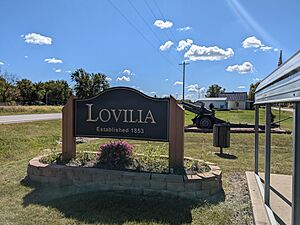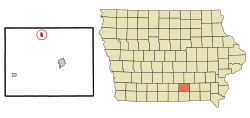Lovilia, Iowa facts for kids
Quick facts for kids
Lovilia, Iowa
|
|
|---|---|

Lovilia welcome sign and cannon
|
|

Location of Lovilia, Iowa
|
|
| Country | |
| State | |
| County | Monroe |
| Area | |
| • Total | 0.52 sq mi (1.35 km2) |
| • Land | 0.52 sq mi (1.35 km2) |
| • Water | 0.00 sq mi (0.00 km2) |
| Elevation | 935 ft (285 m) |
| Population
(2020)
|
|
| • Total | 472 |
| • Density | 904.21/sq mi (349.25/km2) |
| Time zone | UTC-6 (Central (CST)) |
| • Summer (DST) | UTC-5 (CDT) |
| ZIP code |
50150
|
| Area code(s) | 641 |
| FIPS code | 19-46830 |
| GNIS feature ID | 2395775 |
Lovilia is a small city located in Monroe County, Iowa, in the United States. In 2020, about 472 people lived there.
Contents
History of Lovilia
Lovilia was founded in 1853. For many years, coal mining was a very important industry around Lovilia. There were many smaller mines in the area.
Mining Accidents and Safety
On March 30, 1953, a serious dust explosion happened at the O'Brien Mine near Lovilia. Two men were in the mine to set off black-powder shots and were killed in the blast. Volunteers from Lovilia helped bring out their bodies.
Later, the mine owner and other officials went into the mine to investigate. Sadly, some of them were overcome by dangerous air and also died. The investigation found that the explosion was caused by a "blow-out." This happens when the force of the explosion pushes the material meant to seal the hole out, instead of breaking the coal.
Coal Mining in Recent Times
In 1972, the Lovilia Coal Company was still operating one of the last two underground coal mines in Iowa. This mine used a method called "room and pillar" mining. It employed 21 workers and produced a lot of coal that year.
By 1985, the Star Coal Company of Lovilia was the biggest employer in Monroe County, Iowa. It had 150 employees and produced about 500,000 tons of coal each year. This was about 80% of all the coal produced in Iowa at that time!
Geography of Lovilia
Lovilia is located in Iowa. According to the United States Census Bureau, the city covers a total area of about 0.50 square miles (1.3 square kilometers). All of this area is land.
Population and People
In 2020, the city of Lovilia had a population of 472 people. The population density was about 904 people per square mile. Most of the people living in Lovilia are White. A small number of people are from other racial backgrounds or from two or more races.
The average age of people in Lovilia in 2020 was around 39 years old. About 26.5% of the residents were under 20 years old. Many households in Lovilia are made up of married couples living together.
Education
Students in Lovilia attend public schools operated by the Albia Community School District.
See also
 In Spanish: Lovilia para niños
In Spanish: Lovilia para niños

